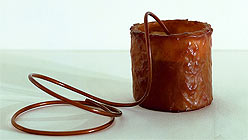Eva Hesse was 34 when she died from a brain tumor in 1970. In her short life she was incredibly prolific, making sculptures that influenced painters, drawers and object-makers alike. Her pieces are immediately recognizable: largely amorphous constructs made from materials like fiberglass, latex, and resin. Her work has been described as post-minimal; spare but process-based, her sculptures and installations reference bodies — or at least their containers — and always seem to be caught in the midst of transforming from one thing to another.
Eva Hesse: Studiowork at Berkeley Art Museum is just that: two rooms filled with rarely (if ever) seen small-scale sculptures. Labeled “thought-experiments” by the artist, all of these little pieces draw on some combination of latex, wire, rubber, string, canvas, gouache, enamel, wire, paper mache, fiberglass, resin, metal, tape, back wax, and unglazed ceramic. While these materials are Hesse staples, these small studies feel less resolved, more ephemeral, and willing to misbehave. Perhaps it is their size — they are not so much studies as miniatures — but also the manner in which they interact: displayed in groupings (on a large, low table in the front room, and in several elegant vitrines in the back room) they appear like small, dehydrated wild animals.

The combinations feel careful though unexpected, as if placed there by proud scientists who discovered variant species living within the same otherworldly ecosystem. The assortments, like the objects themselves, are curious and delicate. Each purposeful object enhances the strangeness of the others.

While Hesse’s “studiowork” is a great discovery, a peek behind the curtain comes with mixed feelings. The studies further illuminate a great artist’s practice, an artist who should have had more time to make more work, and yet a viewer has to wonder: is this work that was intended to be seen? Are “thought experiments” just that: intended to be private moments free of scrutiny? It’s an interesting question to consider, and an impossible one to answer. In the last interview of her life, Hesse told Cindy Nemser, “Life doesn’t last; art doesn’t last.” And yet, forty-one years after her death, her art does last, whether she likes it or not.


